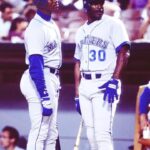SMU Football: Back From The Dead

More than 20 years after being given the "death penalty" by the NCAA, SMU football is heading back to a bowl game.
Illustrating that in college football even death isn’t permanent, the Southern Methodist University (SMU) Mustangs will take the field for the Sheraton Hawaii Bowl this week, 25 years after playing in their last bowl game and 23 years after their program was left for dead by the NCAA.
For an entire generation of fans, SMU is best known for having the only football program ever given the “death penalty” by the NCAA for repeated rules violations. However, to define the football history of the school only by the last 25 years is to neglect a rich and historic tradition that is an important part of college football history.
Though the football programs at Texas, Texas A&M and Texas Christian (TCU) are all older, it didn’t take long after starting football in 1915 for SMU to join them to form a dominant football juggernaut within the state of Texas. Between 1927 and 1941, each school claimed a share of at least one national championship.
In 1915, Texas and Texas A&M were among the founding members of the Southwest Conference. SMU joined the league in 1918 and soon was contending for league titles.
The first great football team at SMU was under the guidance of coach Ray Morrison in 1923. The Mustangs registered shutouts in seven of their nine games and outscored their opponents 207-9 while claiming their first SWC title with a perfect 9-0 record.
The following season, SMU made their first bowl appearance, but lost the Dixie Classic (the forerunner to the Cotton Bowl) to West Virginia Wesleyan 9-7. In 1926 the only blemish on the record for the Mustangs was a 7-7 tie with Missouri as they posted an 8-0-1 record and claimed their second conference title. Another league title followed in 1931 as the Mustangs went 9-1-1.
In 1935 Madison Bell became head coach and in his first season led the Mustangs to a magical year. After ten games, both SMU and rival TCU were undefeated and were ranked first and second, respectively, in the nation. The winner would have the inside track to the national title and a trip to the Rose Bowl.
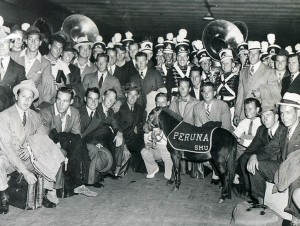
The 1935 SMU team, shown with the band and the mascot, went 12-1 and claimed the first national title in school history.
With quarterback “Slingin” Sammy Baugh leading the Horned Frogs and All-American running back Billy Wilson pacing the Mustangs, the two teams played a contest that came to be known as the Game of the First Half Century.
The game was tied in the final minutes until SMU faced a fourth and four from the TCU 37-yard line. From punt formation, quarterback Bob Finley instead threw a deep pass to Wilson, who caught the ball at the four-yard line and waltzed in for the game-winning score.
The pass was later dubbed “the $85,000 touchdown” in reference to the payout SMU received for their appearance in the Rose Bowl.
SMU lost the Rose Bowl to Stanford 7-0, but were still selected the national champion by the Dickinson system. In 13 games, they outscored their opponents 288 to 39.
The next great SMU teams came a decade later when the greatest player in school history helped them to consecutive conference titles and back-to-back trips to the Cotton Bowl.
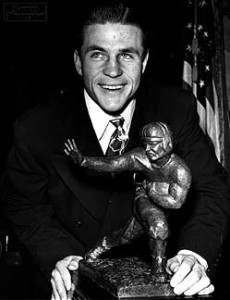
Much like Tim Tebow today, 1948 Heisman Trophy winner Doak Walker was a national icon and not just a college football player.
Doak Walker was the 1940s version of current college football superstar Tim Tebow. Walker was a great player on the field, but his popularity transcended the game, thus taking both Walker and college football as a whole to a new level. The popularity of Walker was so great that a second level was built at the Cotton Bowl (often known as “The House That Doak Built”) to accommodate the large crowds clamoring to see him play.
A three-time All-American, Walker is considered by many to be the best player in Southwest Conference history. Walker claimed the Heisman Trophy as the best college football player in the country as a junior in 1948 and finished third in the voting as both a sophomore and senior. In 35 career games, he scored 303 career points and registered more than 3,500 yards rushing and passing.
Despite having a number of future NFL stars including Kyle Rote Sr., Forrest Gregg, Don Meredith, Jerry Mays, Bill Forester, Jerry Norton and Raymond Berry on the squad throughout the 1950s, the Mustangs were unable to duplicate the same level of success enjoyed in previous decades.
Further illustrating the rich history and tradition of SMU football, another Mustangs’ player during the 1950s was Lamar Hunt, who would go on to help start the American Football League and eventually would become the first of four former SMU football players enshrined in the Pro Football Hall of Fame.
In 1962, the Mustangs hired Arkansas assistant coach Hayden Fry to guide the program. After struggling during his first four seasons, Fry led the Mustangs to their first SWC championship in 18 years in 1966. The Mustangs earned a bid to the Cotton Bowl, but were defeated by Georgia.
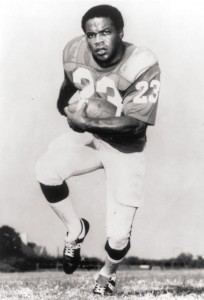
Jerry LeVias, the first African-American scholarship player in the SWC, was an All-American on the field and in the classroom.
It was during Fry’s tenure that SMU became the first school in the SWC to give a scholarship to an African-American football player. Jerry LeVias was not just an All-American receiver for the Mustangs, but also an Academic All-American.
As a sophomore in 1966, LeVias was a key member of the conference championship squad. As a senior, he helped SMU to an 8-3 record and a victory over Oklahoma in the Bluebonnet Bowl.
Several SMU players from the 1960s and 1970s went on to have prominent NFL careers including LeVias, Mike Livingston, Louie Kelcher, Wayne Morris, Ray Schoenke and Dennis Partee.
Fry was fired following the 1972 season and in 1976 UNLV coach Ron Meyer was hired to guide the Mustangs. In 1980 he led SMU to an 8-4 record and their first bowl appearance since 1968.
The Mustangs seemed headed to victory in the Holiday Bowl as they led BYU 45-25 with little more than two minutes remaining in the contest. Amazingly, quarterback Jim McMahon led the Cougars to three late touchdowns and a stunning 46-45 victory.
However, led by the dynamic running tandem of Eric Dickerson and Craig James, the “Pony Express” was just getting started.
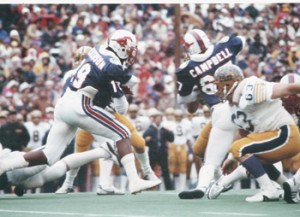
Eric Dickerson and SMU defeated Pittsburgh in the Cotton Bowl following the 1982 season. Dickerson was third in the balloting for the 1982 Heisman Trophy.
SMU won their first conference title in 16 years and finished the 1981 season ranked fifth in the nation with a 10-1 record.
The following year under new head coach Bobby Collins, the only blemish on the record was a 17-17 tie with Arkansas in the final game of the regular season. SMU claimed their second straight SWC title and defeated Pittsburgh in the Cotton Bowl to finish ranked second in the country with an 11-0-1 record.
In 1981 the National Championship Foundation and in 1982 the Helms Athletic Foundation recognized the Mustangs as the top team in the country. The Mustangs finished with a 10-2 record in both 1983 and 1984. In 1984, the Mustangs were co-champions of the SWC and defeated Notre Dame in the Aloha Bowl.
Quarterback Lance McIlhenny was 34-5-1 during his tenure as the starting quarterback. Dickerson finished his career as SMU’s all-time leading rusher and finished third in the Heisman Trophy voting in 1982.
Other prominent Mustangs during this period included Wes Hopkins, Jerry Ball, Joe Phillips, Russell Carter, Michael Carter, Rod Jones, Ron Morris and Reggie Dupard.
Just as SMU was enjoying the greatest prolonged period of success in the history of the football program, the roof caved in.
After being put on probation for recruiting violations in 1985, SMU was again investigated by the NCAA the following year for allegedly making approximately $61,000 in booster payments to players in 1985 and 1986.
It was later discovered that SMU players and in some cases their parents, had been receiving money through a “slush fund” since the 1970s and that the administration became aware as early as 1981.
Because SMU was already on probation when the second set of violations were discovered, the Mustangs were eligible for what was termed the “death penalty” where the NCAA could suspend a program in an attempt to purge the culture of chronic abuse. This radical approach had been used only twice by the NCAA, both times in the sport of men’s basketball, in 1952 at the University of Kentucky and from 1973-75 at the University of Southwestern Louisiana.
After the NCAA suspended the SMU football program for the 1987 season, the school also canceled the 1988 season.
Even though the football program was reinstated in 1989, the devastating impact of the NCAA punishment was evident for the next two decades.
The once proud tradition of the Southwestern Conference began a steady decline around the same time that SMU’s program was banished. Only three members of the SWC did not receive NCAA punishment during the 1980s. As a result, the top teams in the conference were no longer prominent on the national stage.
Following the completion of the 1995-96 school year the SWC officially disbanded.
Many of the top schools from the league, including Texas, Texas A&M and Baylor, joined the Big Eight (which became the Big 12). Because SMU was still struggling to recover from the “death penalty”, the school was passed over by the Big 12 and instead joined the Western Athletic Conference (WAC). In 2005 they moved to Conference USA.
When football returned to SMU in 1989 the head coach was former NFL coach and Hall of Fame player Forrest Gregg, but in two seasons coaching his alma mater Gregg could muster only three victories.
Between 1989 and 2008, SMU managed only one winning season and four years with as many as five victories.
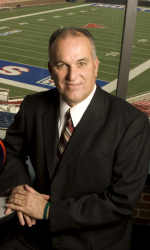
In just two years, June Jones has SMU back in a bowl game for the first time in 25 years.
However, under the direction of second year head coach June Jones, in 2009 the Mustangs posted a 7-5 record and earned their first bowl trip since facing Notre Dame in the Aloha Bowl on December 29, 1984.
Proving that things do come full circle, the Mustangs will be back in Hawaii nearly 25 years later to face Nevada in the Hawaii Bowl on Christmas Eve.
Regardless of whether SMU is victorious on the field in Hawaii, the Mustang players can revel in the fact that through their performance in 2009 they will be adding their own positive chapter to the storied history of SMU football and forever proving that in college football you can come back from the dead.
